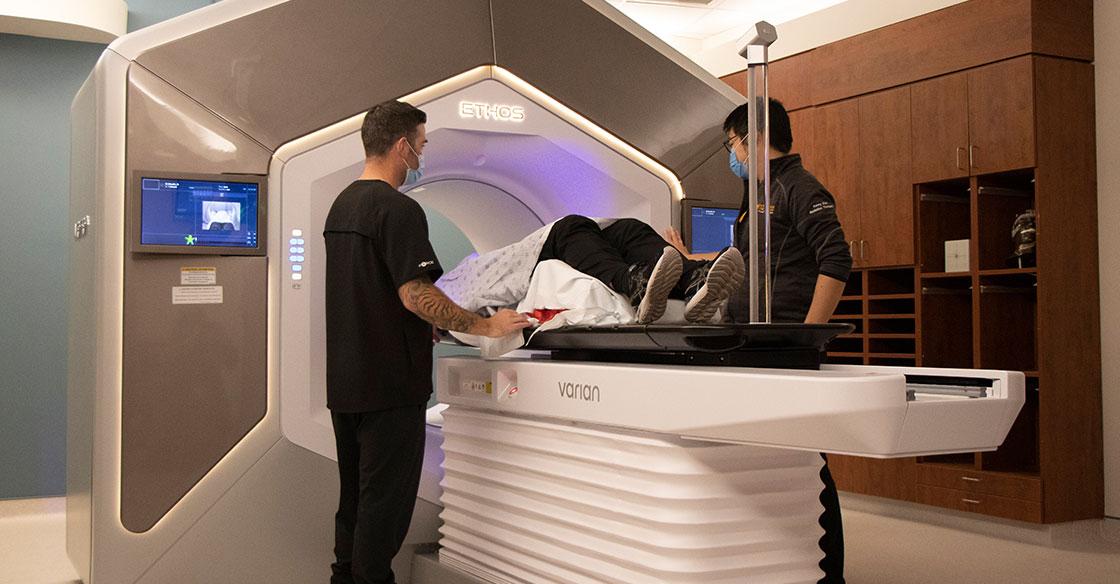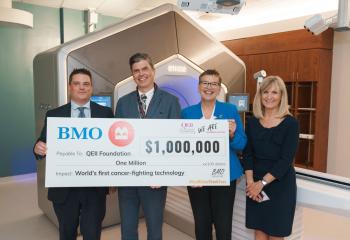
Originally published via the Chronicle Herald and SaltWire.com
Since embarking upon the largest healthcare fundraising campaign in the history of Atlantic Canada, the QEII Foundation has been hard at work to revolutionize care at the QEII Health Sciences Centre and beyond.
At a press conference on June 16, the QEII Foundation announced it will receive some critical help through a $1-million donation from BMO. The gift, which is part of the QEII Foundation’s $100-million We Are campaign, will help fund a new radiation technology that has the potential to transform cancer treatment on a global scale.
With the initiation of a clinical study, the QEII has become the first hospital in the world to obtain images of human trial participants on an Ethos therapy system equipped with the new HyperSight™ imaging technology. The Ethos system is designed to enable clinical teams to deliver adaptive radiotherapy, which allows the clinician to adjust the patient's treatment plan to reflect changes in the tumor or surrounding tissue, in real time during a treatment appointment.
QEII cancer care experts are working with industry collaborator, Varian, on this next-generation advancement that holds significant promise for radiation therapy.
Dr. James Robar, chief of medical physics for Nova Scotia Health and a professor of radiation oncology at Dalhousie University, describes the technology as an innovative treatment platform that allows cancer care experts to deliver radiation treatment in a hyper-precise way.
“Ethos is a quantum leap in the way we can potentially target tumours and keep up with changes within a patient’s anatomy during a multi-day course of radiation therapy,” he says. “It leverages state-of-the-art imaging to get exquisite pictures of our patients in three dimensions, then it uses that imaging to adapt the patient’s day-to-day treatment.”
Paired with the world’s first HyperSight imaging technology, Ethos enables real-time, high-quality images of the patient’s tumour, organs and surrounding tissue – capturing all this information in just six seconds. The image acquisition process can occur within one single breath hold, about 10 times faster than conventional linear accelerator-based imaging systems.
BMO stepped forward as the first QEII Foundation donor to support this technology, which is allowing QEII experts to explore a potentially more precise, personalized, efficient form of radiotherapy.
That precision could result in a host of potential benefits, including fewer side effects and better treatment outcomes for patients.
Robar adds that getting this technology would not have been possible without generous donations like BMO’s.
“This gift from BMO has been invaluable in helping to make this project a reality,” he says.
Justin Scully, BMO’s regional president of personalized banking in the Atlantic provinces, says he is proud to see the bank step up in support of cancer care.
When the QEII Foundation first launched the We Are campaign, Scully knew he wanted to approach the BMO executive committee and ask them for their support. But he also knew that he needed to find, in partnership with the QEII Foundation, the right project – one that was both innovative and transformational.
Ethos therapy featuring HyperSight imaging technology was just that project.
“For patients, access to this technology could mean their radiation treatments have the potential to be more precise than ever before, and it’s almost hard not to get emotional thinking about the impact that could have on patients and families, says Scully. “I think that all our employees at BMO can be proud of that potential impact.”
This is not the first time that BMO has joined forces with the QEII Foundation in support of cancer treatment in Nova Scotia. From supporting the Bust a Move for Breast HealthTM fundraising event to help build the Breast Health Centre to their role as title sponsor of BMO Ride for Cancer which is headed into its ninth year, BMO has an established legacy of championing innovations in local cancer care.
With this gift, BMO is expanding its reach in a big way. Fifty per cent of patients diagnosed with cancer will require radiation at some point during their cancer journey. The ground-breaking treatment method has the potential to one day transform how those patients receive care.
“I think the fact that we can lead the world from right here in Halifax is something to be proud of,” says Scully. “When you look at some of the other investments in innovation that will happen through the QEII Foundation’s We Are campaign, world leaders – both as clinicians and innovators – will be attracted to places that dare to say, ‘We’re going to make these types of investments and lead the world.’”
Healthcare experts are already starting to take notice. To date, two additional medical physicists have been recruited to the QEII to work with this Ethos system featuring HyperSight technology.
Susan Mullin, president and CEO of the QEII Foundation, commends BMO for their visionary support of this project and the We Are campaign.
“Having BMO step up so early and in such a big way with a $1-million donation is a really significant gift to us, and we’re just thrilled,” she says. “BMO has a longstanding history of supporting cancer care in our region and this investment is a prime example of that.”
She says the fact that local partners, like BMO, were quick to get involved in supporting the new technology and the world-leading research that will accompany it is a huge vote of confidence in the talent at the QEII.
It’s a sentiment echoed by Dr. Gail Tomblin Murphy, vice president of research, innovation and discovery at Nova Scotia Health.
“We believe this remarkable technology will truly transform the lives of Nova Scotians,” says Tomblin Murphy. "Nova Scotia Health’s Innovation Hub is proud to provide the kind of adaptable, agile, and creative space for researchers, clinical teams, partners, and investors that helps us capitalize on solutions brought forward by the brightest minds. And with the generosity of donors, like BMO, I know we’ll continue to see even more innovation in health care that will have impact regionally, nationally, and globally.”
Research work utilizing HyperSight on the Ethos system is ongoing at the QEII, following the Investigation Testing Authorization granted by Health Canada.
"We are eager to evaluate the potential benefits of HyperSight, including how it may enhance the patient experience," Robar says. "The ability to acquire high-quality images during the normal course of treatment and in just six seconds provides an exciting opportunity to potentially deliver more efficient, comfortable care.”
For Dr. Robar, the announcement of BMO’s $1-million donation and the innovation it’s helped unlock is just the beginning of something bigger.
“I feel like this is the next chapter in radiation oncology,” he says. “It’s the next big leap as we strive to deliver better care and achieve better outcomes for our patients.”
To learn more about BMO’s gift and its impact on cancer care at the QEII and beyond, visit here.
